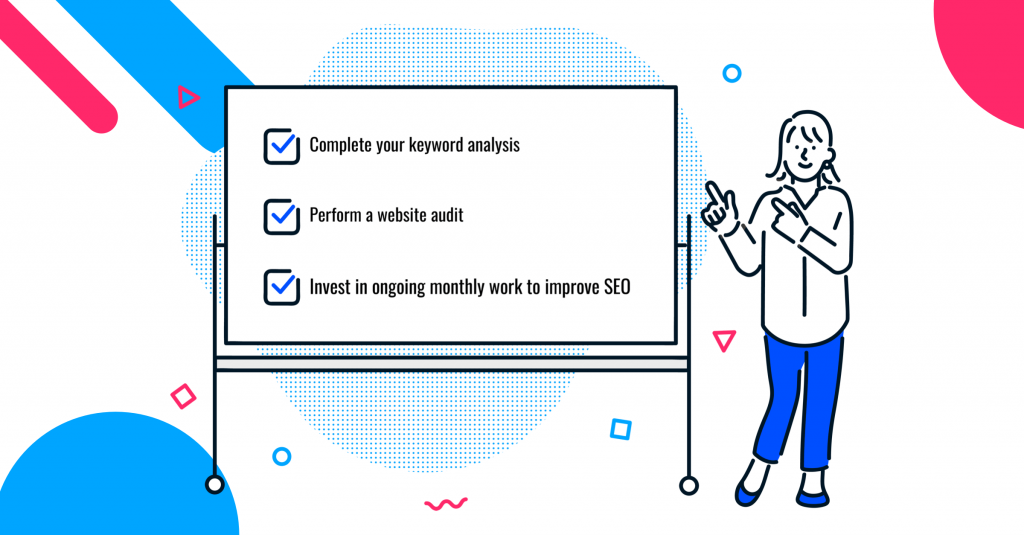It was in that dead zone, the no-man’s land between Christmas and the New Year that I watched Dirty Dancing for the first time. Sure, I’ve been ‘told’ to watch it a million times. And over the years I’ve wavered between the thought that something so famous must be overrated and being too lazy to bother switching it on.
So, I watched it. All the way to the bit where Patrick Swayze lifts Jennifer Grey over his head. And it was fun. Later, I thought that although something is said to be ‘good for you’ we don’t always listen and follow the advice. And the same might be said for certain practices when it comes to marketing. SEO is said to be ‘very good’ for your digital marketing strategy. But for a lot of businesses, it gets… put in a corner. So let’s find out how to improve your SEO.
Want to improve your SEO?
Just like Patrick Swayze’s dancing talent, inbound marketing requires great content to achieve the right results. But the traffic to that content and visitors’ engagement with it can be given a real boost by a well-planned and executed SEO offering. Kind of like how Johnny Castle’s summer changes after he’s introduced to Frances ‘Baby’ Houseman. Let’s look at what makes up a great SEO strategy and the results you could expect, and I bet you’ll never think of putting SEO in a corner again.
How to improve your SEO? Let’s get going.
1. Complete your keyword analysis
We’ve moved past the days when a website or piece of content could get away with keyword stuffing. Today, it’s about well-researched and carefully chosen keywords used in the correct manner to be effective. And remember, keep that content educational, engaging, and relevant (stay away from an over-reliance on 80s film references, for example).
Quick keyword advice:
- Choose keywords with high search rates and low competition
- Opt for both short and long-tail keywords
- Use local keywords (in terms of your geographic location)
- Optimise titles, URLs and on-page SEO
Questions you should ask:
- What keywords should we be targeting and why?
- What is the strategy to take when it comes to the difficulty of a keyword, against search volume and time?
- What are our competitors’ strategies?
2. Perform a website audit
A website audit is like an audition before you are accepted into a summer dance troupe at your family’s country club. An audit will give you a comprehensive evaluation of how you’re performing right now for SEO, across your website and other inbound marketing touchpoints. There are several content and performance metrics to consider. These include:
- Site authority
- Security
- Organic traffic
- Search visibility
- Link profile
- Bounce rate
- Pages per session
- Site responsiveness
3. Invest in ongoing monthly work to improve SEO
Research and audits are the prep work. Then comes the big dance. To ensure you climb the search rankings for chosen keywords you need to invest in monthly work. This requires a comprehensive set of on-page and off-page techniques and strategies. Ongoing optimisation looks like this:
> Tracking and monitoring keywords
Track and monitor keyword performance, tweaking/adding/removing keywords as required and optimising pages to further boost rankings.
> Site updates, maintenance and improvements
Improve the SEO appeal of the site, including domain authority. This work varies day by day, month by month – looking at site speed, visual design elements, landing page conversions tactics, Google search console, etc.
> Competitor analysis
Track and monitor competitor activities, strategies, successes and failures, and then, importantly, use this information to inform your own work and SEO approach.
> Backlink strategy
It’s worth putting a little thought into your backlink strategy. This includes contacting suitable sites to publish content and understanding what type of content works best on these sites. At Fifty Five and Five, for example, we have built an extensive network of contacts which helps us place the right content on the right sites, boosting domain authority in the correct manner.
> Monthly reporting
Create a comprehensive monthly report—detailing all activity for that month, metrics and successes, and plans for the next month. This might seem like the last thing you would want to do at the end of the month but it’s crucial. And it brings us nicely on to…
The importance of KPIs and benchmarking
If you improve your SEO, but don’t track the data, what is the point? KPIs and benchmarking are important because they keep business objectives at the forefront of any decision-making across your marketing strategy. As you put your strategy to work, make sure you take the time to set KPIs and benchmark your current traffic so you can monitor the success of a campaign, or if you need to make adjustments.
> KPIs
Key Performance Indicators are a type of performance measurement that evaluate the success of your campaign or your SEO strategy as a whole. For example, in paid media campaigns, a KPI would be the number of clicks, CTRs or impressions your ad gets. The same can be applied to a piece of content, a page on your website or landing page.
> Benchmarking
Benchmarks are standards against which you can compare your KPIs to measure the success of the campaign. Using the paid media example again, a benchmark of CTR for LinkedIn in the UK is, say, 0.50%; so, if you achieved a CTR of 0.66% for your ad in LinkedIn you can see that the campaign is outperforming the CTR and therefore is going well. Hurray!
Play the long game for SEO success
Just like Patrick Swayze and ‘Baby’s’ relationship your SEO can take time to heat up. In fact, it will usually be several months before you see results. In our experience, though, putting the time into SEO work can really pay off. This is, of course, just a quick guide to putting in place some structure for your business—SEO is a very deep pool and there is a lot to think about and keep on top of.
Some of our clients’ results
Many of our clients asked us to improve their SEO. Here re some examples:
> Increased sessions
Executing a well-planned SEO strategy, our clients have increased the number of sessions on their website on average by 46%. This is based on their starting point prior to their SEO campaign in comparison to their current average sessions over a 12- or 24-month period.
> Better organic traffic
Additionally, clients have seen an average increase in organic traffic by 32%. This is based on their starting point prior to their SEO campaign in comparison to their current average organic traffic over a 12- or 24-month period.
> Higher volume of unique visitors
Furthermore, there has been an increase in unique users by 58%. Again, this is based on the client’s starting point prior to their SEO campaign in comparison to their current average unique users over a 12- or 24-month period.
Turn to the experts to improve your SEO
Want to improve your SEO? We provide advice on all things related to compliment your broader inbound marketing strategy. If you’re confused about the process of adding SEO into your marketing or you could do with some help with the heavy lifting (just like when Swayze lifts…you get the idea), give us a call and we’ll be delighted to help.

